
Project Gutenberg's Montezuma Castle National Monument, Arizona, by Anonymous
This eBook is for the use of anyone anywhere in the United States and most
other parts of the world at no cost and with almost no restrictions
whatsoever. You may copy it, give it away or re-use it under the terms of
the Project Gutenberg License included with this eBook or online at
www.gutenberg.org. If you are not located in the United States, you'll have
to check the laws of the country where you are located before using this ebook.
Title: Montezuma Castle National Monument, Arizona
A guide to discovery of the Castle, its Builders, and Neighbors.
Author: Anonymous
Release Date: October 25, 2019 [EBook #60573]
Language: English
Character set encoding: UTF-8
*** START OF THIS PROJECT GUTENBERG EBOOK MONTEZUMA CASTLE NATIONAL MONUMENT ***
Produced by Stephen Hutcheson, Lisa Corcoran and the Online
Distributed Proofreading Team at http://www.pgdp.net

MONTEZUMA CASTLE NATIONAL MONUMENT
ARIZONA
A guide to discovery of
the Castle,
its Builders,
and Neighbors.
$1.00

Courtesy Sharlot Hall Museum, Prescott
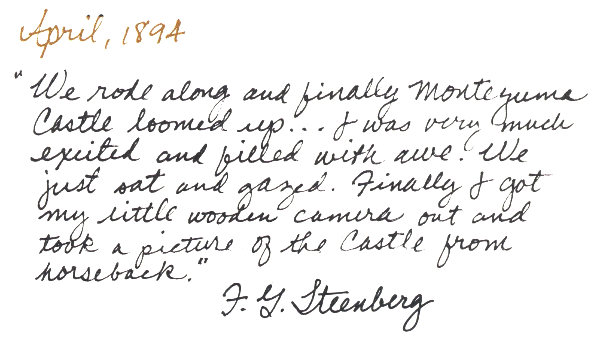
April, 1894
“We rode along and finally Montezuma Castle loomed up.... I was very much excited and filled with awe. We just sat and gazed. Finally I got my little wooden camera out and took a picture of the Castle from horseback.”
F. G. Steenberg
Many early visitors thought this cliff dwelling was a “castle” built by Aztec refugees for their emperor, Montezuma—thus the name!
Thanks to the archeologist, a more realistic story is beginning to unfold. The setting is a prehistoric one, meaning the people involved left no written history. They are believed to be the ancestors of some present-day Southwestern Indians.
This 20-room apartment house was occupied between 1100 and 1400. It has approximately the same floor space as a large, three-bedroom home of today. Perhaps a dozen families, or about 50 people, lived here.
Like other nearby caves and crevasses, the large recess in which the Castle was built is the product of wind and water erosion over eons of time. Shelter from the elements and solar heat from the winter sun were probably good reasons for starting a home here. Other ideas have also been suggested, including protection, tradition, or perhaps the view! However, with no written records to guide us, maybe the real reasons will never be known.
The uppermost wall of the Castle was apparently the first one constructed. It makes two rooms out of a cave in the highest part of the recess. Later additions were made in front of and below these rooms. It appears that modifications were made right up to the time of abandonment!

A ROOF BEAM chopped to length with a stone axe. Was the notch at the end used to help lift the log in place?
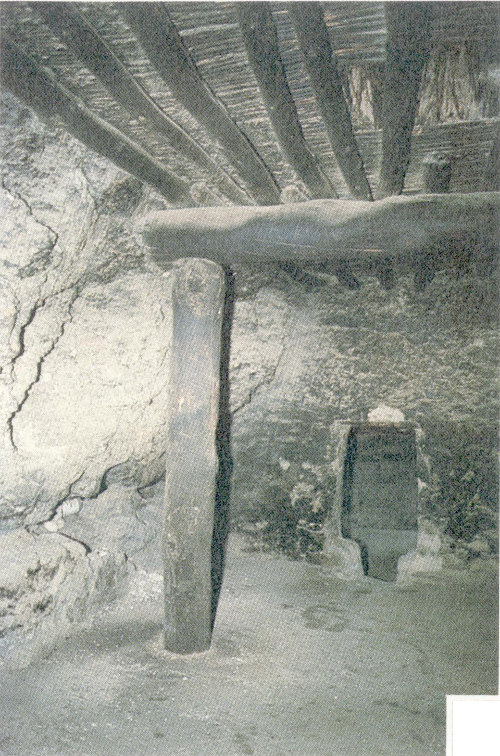
INSIDE A TYPICAL ROOM. Uprights and ceiling beams are from sycamore trees. Ceilings and upper-story floors are a thatching of grasses and shrubs covered with a mud mortar. The small, T-shaped doorway may have helped in regulating air circulation.
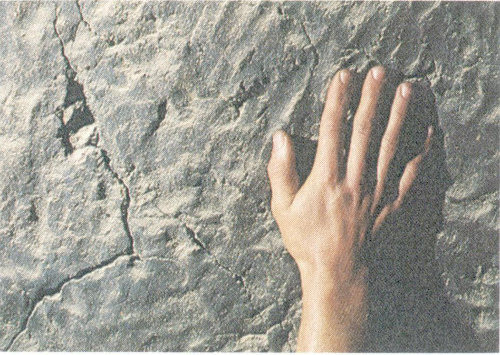
WALLS OF ROCK CEMENTED TOGETHER WITH MUD. Note the handprints of the original plasterer.
Because of the natural overhang and quality of construction, Montezuma Castle stands today as a well-preserved cliff dwelling.

The following are some frequently asked questions about Montezuma Castle
HOW DID THEY GET UP THERE? Probably ladders. Although none were found here, remains of ladders have been found at other prehistoric sites. Are there any materials around here from which they could make ladders? Sycamore and Ash are abundant along the fertile riverbed of nearby Beaver Creek.
THESE PEOPLE HAD NO WRITTEN HISTORY. HOW THEN DO WE KNOW ABOUT THEIR LIVES AND TIMES? The large mound at the base of the cliff contains over three centuries of trash discarded by the cliff dwellers above. As the layers of food-remains, wornout tools and broken pottery accumulated, an unwritten history of the lives and times of these people was provided. What will our dumps and landfills “tell” future archeologists about our lifestyles?
WHY CAN’T WE GO UP THERE? Montezuma Castle is irreplaceable! Most of the structure is over 600 years old and once housed about 50 people. Nearly one-half million people now view this ruin yearly. If the Castle had been open to visitors last year, what would be left for you to enjoy?
ARE THESE OPENINGS AN ENTRANCE TO THE CASTLE? No! These two small caves were probably used for food storage. Being high and dry, such walled-up openings were excellent places to store staples.
Slightly lower and to the west of the castle, there once stood an 8- or 9-room dwelling. Over the centuries natural weathering has reduced this structure to a pile of rocks and dust. Perhaps the people who built in the cliffs chose this site because they understood desert creeks. Occasionally, the flats below are covered by floodwaters.
This ruin has never been excavated. Wouldn’t doing so add to our knowledge of its occupants? Probably. But instead of calling in the archeologists today, why not leave this site undisturbed for a while longer? Archeology is a relatively new science and its techniques are continually being developed and refined. Could the information buried here be of greater value in the future?

West of Montezuma Castle, at the base of the cliff, is Castle A. In 1934 the ruin was excavated by archeologists. This “dig” provided insight into the lives of the families who called it home. Let’s step back in time and join the archeologists in a few of these discoveries....

An abandoned room
In one room, scattered here and there were corncobs, squash stems, beans, and the remains of several stone hoes. A large clay storage pot was found in the right rear corner. By its side, a food grinder was propped up and ready for use. Did we discover the remains of a farmer’s home?
Buried in the room directly behind and above the preceding one were the remains of three infants. The Hopi Indians of northern Arizona believe in burying a child near the mother so that its spirit may enter another newborn. Does the discovery of these burials shed light on the spiritual beliefs of the parents?
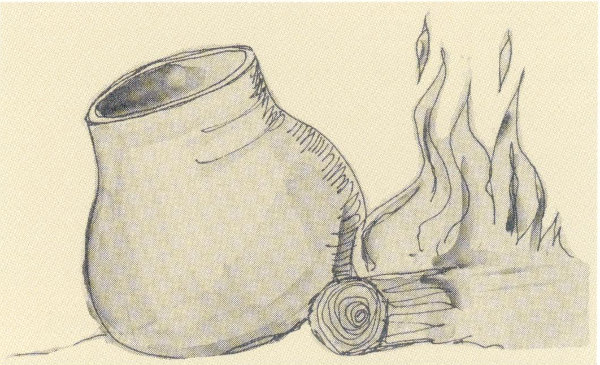
Clay pot
In a room to the left of the child burials a large clay pot was found propped against a firepit. Was this arrangement accidental? Or, did some prehistoric housekeeper devise a method for keeping water hot?

Cloth with patterns and fringe
The caves above contained woven material. Many were made from wild plant fibers for day-to-day use—sandals, skirts, matting, and rope. Other items were woven from cotton, a cultivated “crop.” Some of these fabrics were of dyed yarn and made into intricate designs. Today, weaving is considered an art. Would these prehistoric people agree?
Material goods are frequently found with human remains. Examine the pictures on these pages. These items were discovered with one of the female burials. The pendant and decorated bowl indicate that these people were part of an extensive trading network which covered at least the length and breadth of the Southwest.
Of the fifteen skeletons whose ages could be determined, eleven died before age 45. Some skeletons also provided evidence of arthritis and other bone diseases. And as noted in the archeological report, “... two male skulls showed ... several straight, ragged cuts such as could have been caused by a blunt stone axe.”

The DECORATED BOWL was made in northeastern Arizona about 1350-1400.
The PLAIN BOWL was probably made locally.
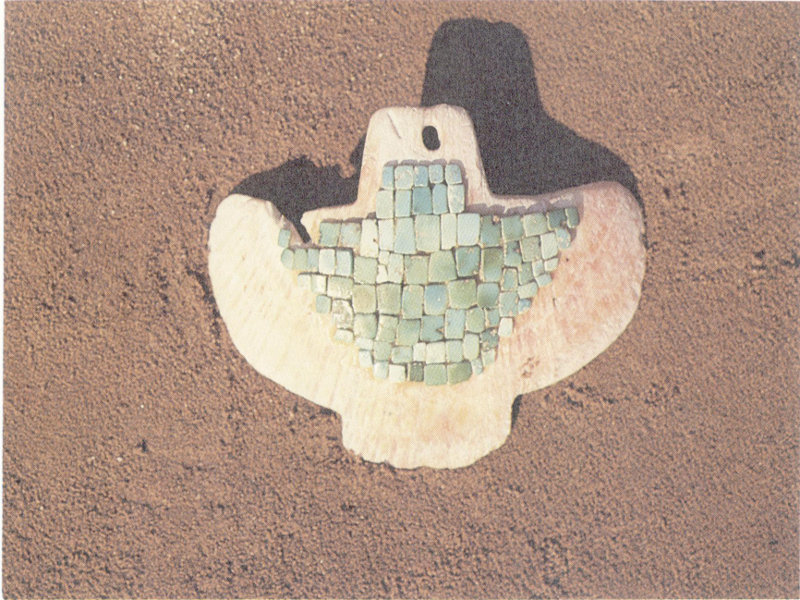
Shell for the background of this NECKLACE PENDANT is from the southern California coast. The turquoise is probably from an area rich in copper.
The backs of over half the skulls were flattened! This could have occurred because infants were often strapped to rigid cradleboards. Whether this deformation was intentional or not is debatable.
If archeologists examine our gravesites 600 years from now, what will they learn about us?

Beaver Creek flows regardless of the season! Most of the time it is gentle and clear. However, dry periods may reduce streamflow to a trickle hidden beneath the rocky creekbed. Limbs and twigs are often lodged in the trees along the creek. This debris is evidence of the power and height of rampaging flood waters. The cliff dwellers probably knew and accepted all these moods.
Directly across the creek, buried beneath years of river deposits, are remnants of prehistoric irrigation ditches. They were used to carry creek water into cultivated fields of corn, beans, squash and cotton.
These farmers also gathered the wild plants and hunted the animals along this streamside.
Keep an eye out for animals! Bones of deer, rabbit, squirrel, snake, turtle, fish and bird were found in the cliff dwellers’ trash mounds.
—Babs Monroe
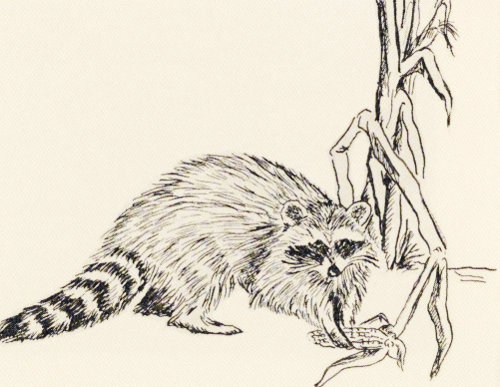
Today, this tree-lined creek provides a relaxing change from the more arid surroundings. To the prehistoric cliff dweller it meant survival.

Archeologists suggest that this was a community of friends, relatives, and neighbors. People going about their daily chores—talking about the weather and the new family next door—or inquiring into the recent death of a newborn or elderly relative.
This village grew and flourished for over 300 years. And yet, when the pilgrims stepped onto Plymouth Rock in 1620, this prehistoric community had been abandoned for over 200 years.
Montezuma Castle National Monument preserves only a few of the hundreds of similar prehistoric ruins discovered in this area.
Again the same sad story applies to the ruins ... all were forsaken, deserted.
Over the centuries they have stood there, empty, forlorn, but ever lovely in the perfection of the dream which created them.
From the CLIFF DWELLERS by W.E.S. Folsom-Dickerson


The “Well,” as it is commonly called, is a separate unit of this National Monument. It is an area rich in cultural and natural history.
Geologists suggest that the Well is a sinkhole formed by water percolating through limestone. Warm, underground springs supply a daily flow of 1½ million gallons, and support a pond life devoid of fish! Nearby are the fossilized remains of irrigation ditches used to carry this water to prehistoric farmlands. Along the Well’s rim are the ruins of these farmers’ homes. Today, the water from Montezuma Well irrigates a nicely shaded picnic area abundant in bird life.
SOUTHWEST PARKS AND MONUMENTS ASSOCIATION
This publication was produced with funds donated by
Southwest Parks and Monuments Association.
www.spma.org
8/01
Recycled paper
End of the Project Gutenberg EBook of Montezuma Castle National Monument,
Arizona, by Anonymous
*** END OF THIS PROJECT GUTENBERG EBOOK MONTEZUMA CASTLE NATIONAL MONUMENT ***
***** This file should be named 60573-h.htm or 60573-h.zip *****
This and all associated files of various formats will be found in:
http://www.gutenberg.org/6/0/5/7/60573/
Produced by Stephen Hutcheson, Lisa Corcoran and the Online
Distributed Proofreading Team at http://www.pgdp.net
Updated editions will replace the previous one--the old editions will
be renamed.
Creating the works from print editions not protected by U.S. copyright
law means that no one owns a United States copyright in these works,
so the Foundation (and you!) can copy and distribute it in the United
States without permission and without paying copyright
royalties. Special rules, set forth in the General Terms of Use part
of this license, apply to copying and distributing Project
Gutenberg-tm electronic works to protect the PROJECT GUTENBERG-tm
concept and trademark. Project Gutenberg is a registered trademark,
and may not be used if you charge for the eBooks, unless you receive
specific permission. If you do not charge anything for copies of this
eBook, complying with the rules is very easy. You may use this eBook
for nearly any purpose such as creation of derivative works, reports,
performances and research. They may be modified and printed and given
away--you may do practically ANYTHING in the United States with eBooks
not protected by U.S. copyright law. Redistribution is subject to the
trademark license, especially commercial redistribution.
START: FULL LICENSE
THE FULL PROJECT GUTENBERG LICENSE
PLEASE READ THIS BEFORE YOU DISTRIBUTE OR USE THIS WORK
To protect the Project Gutenberg-tm mission of promoting the free
distribution of electronic works, by using or distributing this work
(or any other work associated in any way with the phrase "Project
Gutenberg"), you agree to comply with all the terms of the Full
Project Gutenberg-tm License available with this file or online at
www.gutenberg.org/license.
Section 1. General Terms of Use and Redistributing Project
Gutenberg-tm electronic works
1.A. By reading or using any part of this Project Gutenberg-tm
electronic work, you indicate that you have read, understand, agree to
and accept all the terms of this license and intellectual property
(trademark/copyright) agreement. If you do not agree to abide by all
the terms of this agreement, you must cease using and return or
destroy all copies of Project Gutenberg-tm electronic works in your
possession. If you paid a fee for obtaining a copy of or access to a
Project Gutenberg-tm electronic work and you do not agree to be bound
by the terms of this agreement, you may obtain a refund from the
person or entity to whom you paid the fee as set forth in paragraph
1.E.8.
1.B. "Project Gutenberg" is a registered trademark. It may only be
used on or associated in any way with an electronic work by people who
agree to be bound by the terms of this agreement. There are a few
things that you can do with most Project Gutenberg-tm electronic works
even without complying with the full terms of this agreement. See
paragraph 1.C below. There are a lot of things you can do with Project
Gutenberg-tm electronic works if you follow the terms of this
agreement and help preserve free future access to Project Gutenberg-tm
electronic works. See paragraph 1.E below.
1.C. The Project Gutenberg Literary Archive Foundation ("the
Foundation" or PGLAF), owns a compilation copyright in the collection
of Project Gutenberg-tm electronic works. Nearly all the individual
works in the collection are in the public domain in the United
States. If an individual work is unprotected by copyright law in the
United States and you are located in the United States, we do not
claim a right to prevent you from copying, distributing, performing,
displaying or creating derivative works based on the work as long as
all references to Project Gutenberg are removed. Of course, we hope
that you will support the Project Gutenberg-tm mission of promoting
free access to electronic works by freely sharing Project Gutenberg-tm
works in compliance with the terms of this agreement for keeping the
Project Gutenberg-tm name associated with the work. You can easily
comply with the terms of this agreement by keeping this work in the
same format with its attached full Project Gutenberg-tm License when
you share it without charge with others.
1.D. The copyright laws of the place where you are located also govern
what you can do with this work. Copyright laws in most countries are
in a constant state of change. If you are outside the United States,
check the laws of your country in addition to the terms of this
agreement before downloading, copying, displaying, performing,
distributing or creating derivative works based on this work or any
other Project Gutenberg-tm work. The Foundation makes no
representations concerning the copyright status of any work in any
country outside the United States.
1.E. Unless you have removed all references to Project Gutenberg:
1.E.1. The following sentence, with active links to, or other
immediate access to, the full Project Gutenberg-tm License must appear
prominently whenever any copy of a Project Gutenberg-tm work (any work
on which the phrase "Project Gutenberg" appears, or with which the
phrase "Project Gutenberg" is associated) is accessed, displayed,
performed, viewed, copied or distributed:
This eBook is for the use of anyone anywhere in the United States and
most other parts of the world at no cost and with almost no
restrictions whatsoever. You may copy it, give it away or re-use it
under the terms of the Project Gutenberg License included with this
eBook or online at www.gutenberg.org. If you are not located in the
United States, you'll have to check the laws of the country where you
are located before using this ebook.
1.E.2. If an individual Project Gutenberg-tm electronic work is
derived from texts not protected by U.S. copyright law (does not
contain a notice indicating that it is posted with permission of the
copyright holder), the work can be copied and distributed to anyone in
the United States without paying any fees or charges. If you are
redistributing or providing access to a work with the phrase "Project
Gutenberg" associated with or appearing on the work, you must comply
either with the requirements of paragraphs 1.E.1 through 1.E.7 or
obtain permission for the use of the work and the Project Gutenberg-tm
trademark as set forth in paragraphs 1.E.8 or 1.E.9.
1.E.3. If an individual Project Gutenberg-tm electronic work is posted
with the permission of the copyright holder, your use and distribution
must comply with both paragraphs 1.E.1 through 1.E.7 and any
additional terms imposed by the copyright holder. Additional terms
will be linked to the Project Gutenberg-tm License for all works
posted with the permission of the copyright holder found at the
beginning of this work.
1.E.4. Do not unlink or detach or remove the full Project Gutenberg-tm
License terms from this work, or any files containing a part of this
work or any other work associated with Project Gutenberg-tm.
1.E.5. Do not copy, display, perform, distribute or redistribute this
electronic work, or any part of this electronic work, without
prominently displaying the sentence set forth in paragraph 1.E.1 with
active links or immediate access to the full terms of the Project
Gutenberg-tm License.
1.E.6. You may convert to and distribute this work in any binary,
compressed, marked up, nonproprietary or proprietary form, including
any word processing or hypertext form. However, if you provide access
to or distribute copies of a Project Gutenberg-tm work in a format
other than "Plain Vanilla ASCII" or other format used in the official
version posted on the official Project Gutenberg-tm web site
(www.gutenberg.org), you must, at no additional cost, fee or expense
to the user, provide a copy, a means of exporting a copy, or a means
of obtaining a copy upon request, of the work in its original "Plain
Vanilla ASCII" or other form. Any alternate format must include the
full Project Gutenberg-tm License as specified in paragraph 1.E.1.
1.E.7. Do not charge a fee for access to, viewing, displaying,
performing, copying or distributing any Project Gutenberg-tm works
unless you comply with paragraph 1.E.8 or 1.E.9.
1.E.8. You may charge a reasonable fee for copies of or providing
access to or distributing Project Gutenberg-tm electronic works
provided that
* You pay a royalty fee of 20% of the gross profits you derive from
the use of Project Gutenberg-tm works calculated using the method
you already use to calculate your applicable taxes. The fee is owed
to the owner of the Project Gutenberg-tm trademark, but he has
agreed to donate royalties under this paragraph to the Project
Gutenberg Literary Archive Foundation. Royalty payments must be paid
within 60 days following each date on which you prepare (or are
legally required to prepare) your periodic tax returns. Royalty
payments should be clearly marked as such and sent to the Project
Gutenberg Literary Archive Foundation at the address specified in
Section 4, "Information about donations to the Project Gutenberg
Literary Archive Foundation."
* You provide a full refund of any money paid by a user who notifies
you in writing (or by e-mail) within 30 days of receipt that s/he
does not agree to the terms of the full Project Gutenberg-tm
License. You must require such a user to return or destroy all
copies of the works possessed in a physical medium and discontinue
all use of and all access to other copies of Project Gutenberg-tm
works.
* You provide, in accordance with paragraph 1.F.3, a full refund of
any money paid for a work or a replacement copy, if a defect in the
electronic work is discovered and reported to you within 90 days of
receipt of the work.
* You comply with all other terms of this agreement for free
distribution of Project Gutenberg-tm works.
1.E.9. If you wish to charge a fee or distribute a Project
Gutenberg-tm electronic work or group of works on different terms than
are set forth in this agreement, you must obtain permission in writing
from both the Project Gutenberg Literary Archive Foundation and The
Project Gutenberg Trademark LLC, the owner of the Project Gutenberg-tm
trademark. Contact the Foundation as set forth in Section 3 below.
1.F.
1.F.1. Project Gutenberg volunteers and employees expend considerable
effort to identify, do copyright research on, transcribe and proofread
works not protected by U.S. copyright law in creating the Project
Gutenberg-tm collection. Despite these efforts, Project Gutenberg-tm
electronic works, and the medium on which they may be stored, may
contain "Defects," such as, but not limited to, incomplete, inaccurate
or corrupt data, transcription errors, a copyright or other
intellectual property infringement, a defective or damaged disk or
other medium, a computer virus, or computer codes that damage or
cannot be read by your equipment.
1.F.2. LIMITED WARRANTY, DISCLAIMER OF DAMAGES - Except for the "Right
of Replacement or Refund" described in paragraph 1.F.3, the Project
Gutenberg Literary Archive Foundation, the owner of the Project
Gutenberg-tm trademark, and any other party distributing a Project
Gutenberg-tm electronic work under this agreement, disclaim all
liability to you for damages, costs and expenses, including legal
fees. YOU AGREE THAT YOU HAVE NO REMEDIES FOR NEGLIGENCE, STRICT
LIABILITY, BREACH OF WARRANTY OR BREACH OF CONTRACT EXCEPT THOSE
PROVIDED IN PARAGRAPH 1.F.3. YOU AGREE THAT THE FOUNDATION, THE
TRADEMARK OWNER, AND ANY DISTRIBUTOR UNDER THIS AGREEMENT WILL NOT BE
LIABLE TO YOU FOR ACTUAL, DIRECT, INDIRECT, CONSEQUENTIAL, PUNITIVE OR
INCIDENTAL DAMAGES EVEN IF YOU GIVE NOTICE OF THE POSSIBILITY OF SUCH
DAMAGE.
1.F.3. LIMITED RIGHT OF REPLACEMENT OR REFUND - If you discover a
defect in this electronic work within 90 days of receiving it, you can
receive a refund of the money (if any) you paid for it by sending a
written explanation to the person you received the work from. If you
received the work on a physical medium, you must return the medium
with your written explanation. The person or entity that provided you
with the defective work may elect to provide a replacement copy in
lieu of a refund. If you received the work electronically, the person
or entity providing it to you may choose to give you a second
opportunity to receive the work electronically in lieu of a refund. If
the second copy is also defective, you may demand a refund in writing
without further opportunities to fix the problem.
1.F.4. Except for the limited right of replacement or refund set forth
in paragraph 1.F.3, this work is provided to you 'AS-IS', WITH NO
OTHER WARRANTIES OF ANY KIND, EXPRESS OR IMPLIED, INCLUDING BUT NOT
LIMITED TO WARRANTIES OF MERCHANTABILITY OR FITNESS FOR ANY PURPOSE.
1.F.5. Some states do not allow disclaimers of certain implied
warranties or the exclusion or limitation of certain types of
damages. If any disclaimer or limitation set forth in this agreement
violates the law of the state applicable to this agreement, the
agreement shall be interpreted to make the maximum disclaimer or
limitation permitted by the applicable state law. The invalidity or
unenforceability of any provision of this agreement shall not void the
remaining provisions.
1.F.6. INDEMNITY - You agree to indemnify and hold the Foundation, the
trademark owner, any agent or employee of the Foundation, anyone
providing copies of Project Gutenberg-tm electronic works in
accordance with this agreement, and any volunteers associated with the
production, promotion and distribution of Project Gutenberg-tm
electronic works, harmless from all liability, costs and expenses,
including legal fees, that arise directly or indirectly from any of
the following which you do or cause to occur: (a) distribution of this
or any Project Gutenberg-tm work, (b) alteration, modification, or
additions or deletions to any Project Gutenberg-tm work, and (c) any
Defect you cause.
Section 2. Information about the Mission of Project Gutenberg-tm
Project Gutenberg-tm is synonymous with the free distribution of
electronic works in formats readable by the widest variety of
computers including obsolete, old, middle-aged and new computers. It
exists because of the efforts of hundreds of volunteers and donations
from people in all walks of life.
Volunteers and financial support to provide volunteers with the
assistance they need are critical to reaching Project Gutenberg-tm's
goals and ensuring that the Project Gutenberg-tm collection will
remain freely available for generations to come. In 2001, the Project
Gutenberg Literary Archive Foundation was created to provide a secure
and permanent future for Project Gutenberg-tm and future
generations. To learn more about the Project Gutenberg Literary
Archive Foundation and how your efforts and donations can help, see
Sections 3 and 4 and the Foundation information page at
www.gutenberg.org
Section 3. Information about the Project Gutenberg Literary Archive Foundation
The Project Gutenberg Literary Archive Foundation is a non profit
501(c)(3) educational corporation organized under the laws of the
state of Mississippi and granted tax exempt status by the Internal
Revenue Service. The Foundation's EIN or federal tax identification
number is 64-6221541. Contributions to the Project Gutenberg Literary
Archive Foundation are tax deductible to the full extent permitted by
U.S. federal laws and your state's laws.
The Foundation's principal office is in Fairbanks, Alaska, with the
mailing address: PO Box 750175, Fairbanks, AK 99775, but its
volunteers and employees are scattered throughout numerous
locations. Its business office is located at 809 North 1500 West, Salt
Lake City, UT 84116, (801) 596-1887. Email contact links and up to
date contact information can be found at the Foundation's web site and
official page at www.gutenberg.org/contact
For additional contact information:
Dr. Gregory B. Newby
Chief Executive and Director
[email protected]
Section 4. Information about Donations to the Project Gutenberg
Literary Archive Foundation
Project Gutenberg-tm depends upon and cannot survive without wide
spread public support and donations to carry out its mission of
increasing the number of public domain and licensed works that can be
freely distributed in machine readable form accessible by the widest
array of equipment including outdated equipment. Many small donations
($1 to $5,000) are particularly important to maintaining tax exempt
status with the IRS.
The Foundation is committed to complying with the laws regulating
charities and charitable donations in all 50 states of the United
States. Compliance requirements are not uniform and it takes a
considerable effort, much paperwork and many fees to meet and keep up
with these requirements. We do not solicit donations in locations
where we have not received written confirmation of compliance. To SEND
DONATIONS or determine the status of compliance for any particular
state visit www.gutenberg.org/donate
While we cannot and do not solicit contributions from states where we
have not met the solicitation requirements, we know of no prohibition
against accepting unsolicited donations from donors in such states who
approach us with offers to donate.
International donations are gratefully accepted, but we cannot make
any statements concerning tax treatment of donations received from
outside the United States. U.S. laws alone swamp our small staff.
Please check the Project Gutenberg Web pages for current donation
methods and addresses. Donations are accepted in a number of other
ways including checks, online payments and credit card donations. To
donate, please visit: www.gutenberg.org/donate
Section 5. General Information About Project Gutenberg-tm electronic works.
Professor Michael S. Hart was the originator of the Project
Gutenberg-tm concept of a library of electronic works that could be
freely shared with anyone. For forty years, he produced and
distributed Project Gutenberg-tm eBooks with only a loose network of
volunteer support.
Project Gutenberg-tm eBooks are often created from several printed
editions, all of which are confirmed as not protected by copyright in
the U.S. unless a copyright notice is included. Thus, we do not
necessarily keep eBooks in compliance with any particular paper
edition.
Most people start at our Web site which has the main PG search
facility: www.gutenberg.org
This Web site includes information about Project Gutenberg-tm,
including how to make donations to the Project Gutenberg Literary
Archive Foundation, how to help produce our new eBooks, and how to
subscribe to our email newsletter to hear about new eBooks.